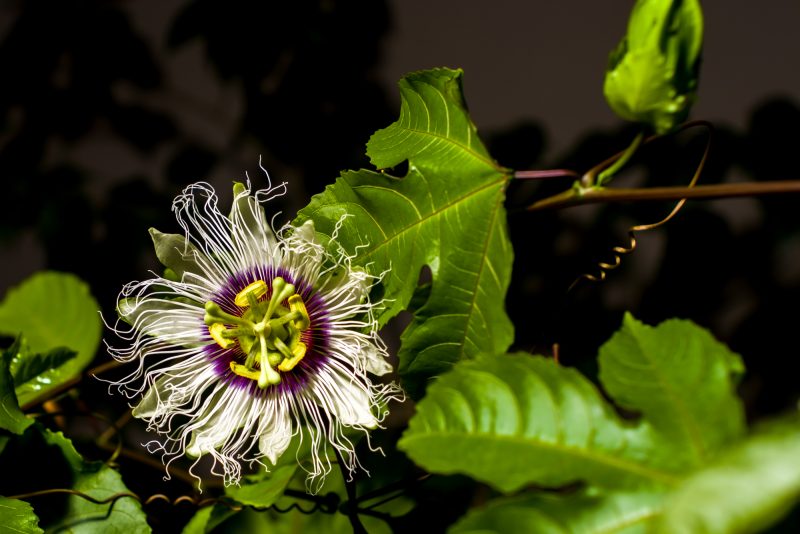Passionfruit is a glorious lush looking vine, with glossy green leaves, and flowers that are intricate and beautiful.
It can grow vigorously, putting out seemingly endless tendrils and fresh tips, even covering itself with flowers.
But then….sometimes we get a little disappointed by the lack of fruit.
To improve your Passionfruit crop, you need to focus on both overall plant health, and also take action during flowering to help develop the fruits.
Let’s start with the health of the plant.
Remove Passionfruit Suckers
Most Passionfruit sold through plant nurseries are grafted varieties. This means it is made up of two different sections of plant tissue – the top being the variety of Passionfruit that we enjoy eating, and the bottom material with the roots usually selected for traits such as disease resistance, tolerance to the cold, or overall vigour.
This vigorous growth trait is good, but it means you need to make sure new growth is coming from above the graft (join) and not below it. It is important to keep an eye on any shoots growing from below the graft point and cut them off.
The shoots can also appear randomly from ground level over time, even some way away from the main stem, so cut/scrape/smash them away too. They can be easily identified as they have a smaller, more lobed leaf, which is not as glossy as the above graft vine.
Why? Because we want to top vine (remember yummy fruit goals!) to get all the growing energy, not the foliage generation from the rootstock.
Fertilisers for Passionfruit
A key tip to improve your Passionfruit crop is to ensure the vine has good access to all the nutrients and trace elements it needs for healthy growth. This is important at planting time, and throughout the life cycle.
If your vine has pale or yellowing leaves, it is a sure sign of Nitrogen deficiency. Other nutrient needs are harder to identify without soil or leaf tissue testing, so I use a general Fruit & Citrus organic pellet fertiliser, and apply every single month to all my fruiting trees and vines. This way I avoid the “sugar rush” effect and keep up a steady supply to the plants.
Be aware that fertilisers with a higher proportion of Nitrogen (shown as N on the label) will encourage leaf growth, so make sure to find one with a good ratio of Phosphorous to support flowering also.
You might be surprised at how much fertiliser is needed….a mature Passionfruit vine would need 500gm of a complete fertiliser applied four times between Spring and early Autumn.
At planting time, you can add a scoop of a pelletised organic fertiliser when you refill the hole so that it is mixed into the soil. I don’t like adding it in the bottom of the hole, as I worry about burning the tiny roots as they are developing. Watering the plant with a seaweed emulsion after planting, and again in a few weeks is always beneficial in helping to establish a new plant.
Pollination of Passionfruit
Now, the next step to increase the number of flowers that turn into fruit. Each Passionfruit has both male and female parts (so that is why they are called self-pollinating), so all that needs to happen is to ensure that pollen gets moved around and has a good shot at fertilising the flowers. Now, of course, bees and other visiting insects assist, but we can also get involved!
A simple way to help things along is to just swipe your hands over the Passionfruit vine – giving it a little shake, or brush past it when you walk past. The goal is just to help distribute the pollen.
A more effective method is to get a paintbrush, or a pastry brush will do – and dab it into a few flowers, then into a few different ones. Keep doing random swabs and dabs and you have done the work of the insects in helping that all-important pollen move to a flower and start fertilisation.
Fruits take 10 to 12 weeks to develop after flowering, so for a continuous crop, keep up with the hand-pollinating efforts whenever you see flowers.
Some other tips with Passionfruit fruiting
Hot, dry Summers can cause the pollen to dry out and become unviable, making fertilisation a failure. Wet conditions can be as problematic, with the pollen unable to be dusted between flowers. There is not a lot you can do if it is a seasonal weather issue, sometimes there are just difficult years!
Passionfruit vines are a short-lived plant, you can expect to replace the vine after around 7 years. You may be able to get a good response to a light pruning in Spring, which can increase the amount of lateral growth – it will mean less Summer fruit but you will get a later crop.
Good luck including these methods to improve your Passionfruit crop, I hope you get more fruit!


